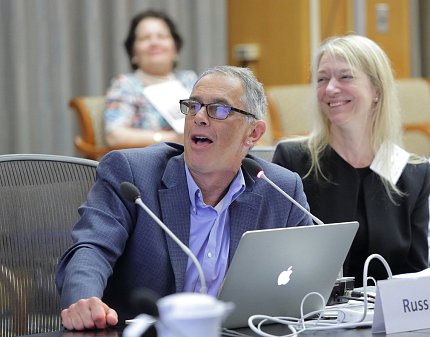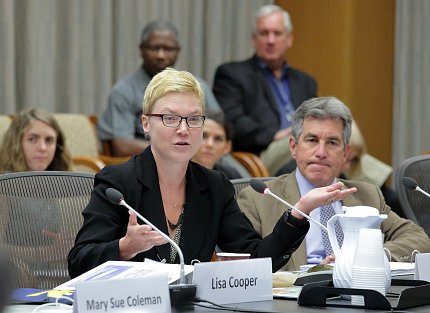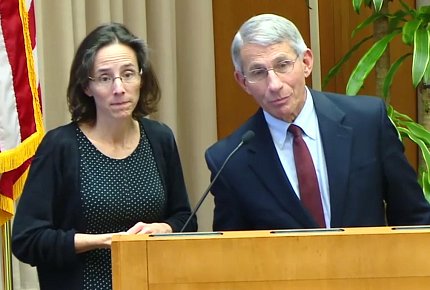‘Poised at an Exciting Moment’
New CC Authority, Grant Disparity, Zika Top ACD Agenda

Photo: Ernie Branson
Crucial topics at home and abroad headlined the most recent meeting of the advisory committee to the NIH director (ACD).
At NIH home base, the Clinical Center’s leadership began to undergo some of its first significant restructuring since opening in 1953, in response to recommendations by the ACD-appointed Red Team [see sidebar 1].
In the extramural community, persistent disparities in funding outcomes for African-American grant applicants will be studied further following new analysis by NIH’s Office of Scientific Workforce Diversity [see sidebar 2].
Globally, the Zika outbreak has spread to Puerto Rico with no signs of slowing. Newly confirmed facts about the virus’s impact on fetuses, newborns and pregnant women require immediate and comprehensive research, according to updates by leaders of NIAID and NICHD [see sidebar 3].
These issues, reports on the Cancer Moonshot and Big Data to Knowledge and more packed the 1½-day ACD agenda June 9-10.
Hopeful Signs on the Funding Front
As is customary, NIH director Dr. Francis Collins began the meeting with a broad view of current events and what’s happened since the group last gathered in December. He welcomed new ACD members Dr. Geoffrey Ginsburg of Duke University and Dr. Linda Griffith of MIT. Collins also talked about recent NIH senior staff appointments and searches under way.

Photo: Ernie Branson
Representatives from NIH legislative and budget offices gave updates and forecasts as well. Attendees were encouraged to hear that another $2 billion increase in the NIH appropriation has been proposed—for the second year in a row—by the Senate for fiscal year 2017. Collins praised success of bipartisan efforts on NIH’s behalf by Sen. Roy Blunt (R-MO) and Sen. Patty Murray (D-WA). The House of Representatives version was expected by the next week. A $1.9 billion emergency supplemental request for Zika is still pending.
Collins also summarized NIH’s “shared efforts in global health research” with the Bill and Melinda Gates Foundation. Bill Gates visited NIH in April at the annual day-long meeting to discuss the joint enterprise. Among topics covered were the human papillomavirus vaccine efficacy trial, collaboration on HIV vaccines, cookstoves and environmental toxin reduction and vector-based interventions for malaria containment.
“If you look at the sources of funds, when you add NIH and the Gates Foundation together you have more than 50 percent of the total world investment in global health research,” Collins noted.
PMI Proceeds Apace
Acknowledging the unprecedented speed with which the Precision Medicine Initiative Cohort Program is moving toward its first ambitious goals, Collins reiterated the program’s core values: Cohort “participants are partners” not patients; the group “needs to reflect the rich diversity of America”; data sharing “has to be swift both to the researchers and to the participants, according to what they wish to know about themselves”; and privacy and security are being “built into every component and taken with the utmost seriousness.”

Photo: Ernie Branson
Hearing the guiding principles re-emphasized, ACD member Dr. Russ Altman enthused, “That’s incredibly exciting. It’s like the Athenian model of democracy, where there are no representatives,” we’re all at the table together.
“This notion of having the participants as partners means that when you’re thinking about what the science is that you’re going to do, that it has to be both kick-ass science and it has to build the relationship with the participants—and we’re sort of more used to doing the kick-ass science,” explained NIH deputy director for science, outreach and policy Dr. Kathy Hudson. “These two things are going to have to go hand in hand from the beginning, which in some cases means that the really satisfying science might come a little bit later, in order to make sure we’re building the relationship, figuring out what people’s preferences are, making sure that we don’t do anything that threatens the trust that we so desperately hope to build.”

Photo: Ernie Branson
The PMI cohort’s first big component—the biobank—was launched, with $142 million over 5 years awarded to the Mayo Clinic to collect and store biospecimens. A PMI advisory panel and a central institutional review board with expertise in mHealth, bioinformatics, health disparities, epidemiology, genomics and other areas have also been established.
“We are trying to make PMI not just a great research project but also a motivator to fix a problem across the country in terms of electronic health records that are not as usable as people wish they were,” Collins said.
By July all the pieces will be decided; the goal, by year’s end, is to have 79,000 individuals enrolled.
“We are poised at an exciting moment,” he said.
Video of ACD proceedings is online at https://videocast.nih.gov/summary.asp?Live=19275&bhcp=1.




